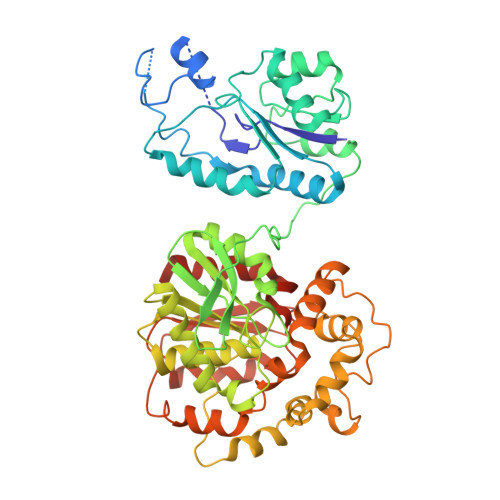Binding of alkylurea inhibitors to epoxide hydrolase implicates active site tyrosines in substrate activation.
Argiriadi, M.A., Morisseau, C., Goodrow, M.H., Dowdy, D.L., Hammock, B.D., Christianson, D.W.(2000) J Biological Chem 275: 15265-15270
- PubMed: 10747889
- DOI: https://doi.org/10.1074/jbc.M000278200
- Primary Citation of Related Structures:
1EK1, 1EK2 - PubMed Abstract:
The structures of two alkylurea inhibitors complexed with murine soluble epoxide hydrolase have been determined by x-ray crystallographic methods. The alkyl substituents of each inhibitor make extensive hydrophobic contacts in the soluble epoxide hydrolase active site, and each urea carbonyl oxygen accepts hydrogen bonds from the phenolic hydroxyl groups of Tyr(381) and Tyr(465). These hydrogen bond interactions suggest that Tyr(381) and/or Tyr(465) are general acid catalysts that facilitate epoxide ring opening in the first step of the hydrolysis reaction; Tyr(465) is highly conserved among all epoxide hydrolases, and Tyr(381) is conserved among the soluble epoxide hydrolases. In one enzyme-inhibitor complex, the urea carbonyl oxygen additionally interacts with Gln(382). If a comparable interaction occurs in catalysis, then Gln(382) may provide electrostatic stabilization of partial negative charge on the epoxide oxygen. The carboxylate side chain of Asp(333) accepts a hydrogen bond from one of the urea NH groups in each enzyme-inhibitor complex. Because Asp(333) is the catalytic nucleophile, its interaction with the partial positive charge on the urea NH group mimics its approach toward the partial positive charge on the electrophilic carbon of an epoxide substrate. Accordingly, alkylurea inhibitors mimic features encountered in the reaction coordinate of epoxide ring opening, and a structure-based mechanism is proposed for leukotoxin epoxide hydrolysis.
- Roy and Diana Vagelos Laboratories, Department of Chemistry, University of Pennsylvania, Philadelphia, Pennsylvania 19104-6323, USA.
Organizational Affiliation:

















